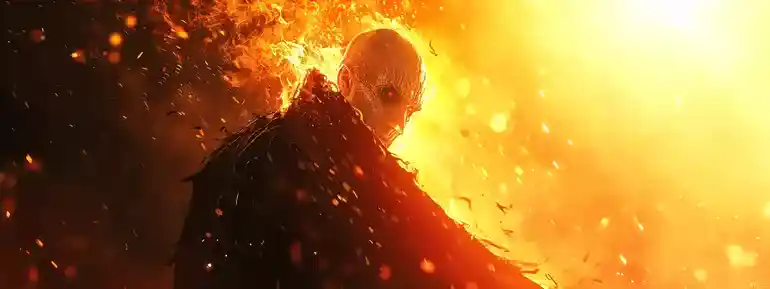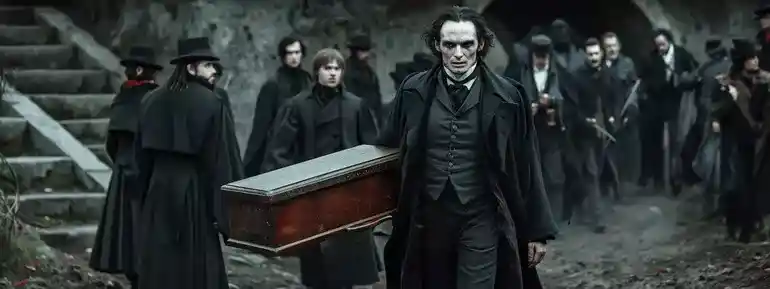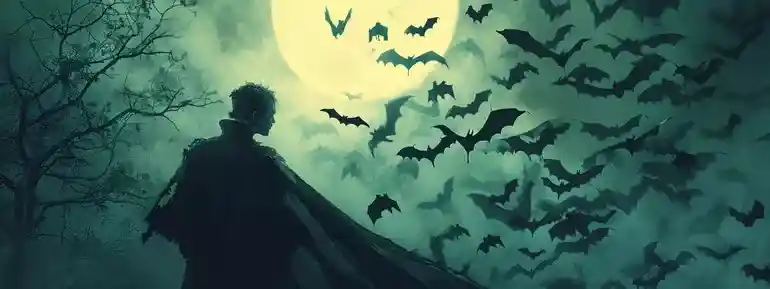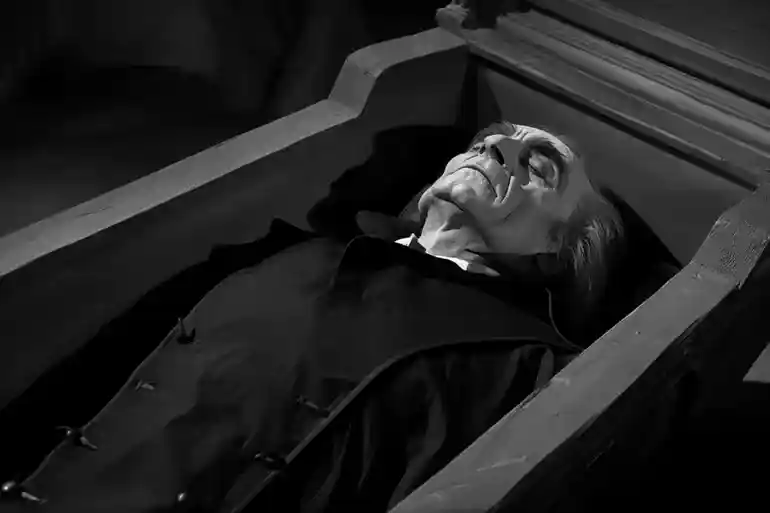Vampires have long been both captivating and terrifying figures in folklore and popular culture. One of the most intriguing characteristics of vampires is their affinity for resting in coffins. From classic vampire literature to modern vampire movies, the image of a vampire sleeping soundly in a coffin has become deeply ingrained in our minds. But why do vampires sleep in coffins? What is the significance of this peculiar sleeping arrangement? In this blog, we will delve into the mystery behind vampires and their bond with coffins, exploring the origins, practical reasons, and supernatural aspects of this vampire trope. So, let’s lift the lid and unveil the secrets of why vampires choose to sleep in coffins.
Vampires and Coffins: An Unusual Attachment
The connection between vampires and coffins may seem unusual, even macabre, to some. However, this unique association sets vampires apart from other creatures of the night. The image of a vampire resting peacefully in a coffin brings forth a sense of mystery, darkness, and the supernatural. But where did this tradition originate, and what does it symbolize for vampires?
Origin of Coffin Usage by Vampires
The trope of vampires sleeping in coffins can be traced back to Bram Stoker’s iconic novel, “Dracula,” published in 1897. In the novel, the title character, Count Dracula, is depicted sleeping in a stone coffin to regain his strength during daylight hours. This imagery of vampire sleeping arrangements has since become a staple in vampire lore and popular culture. In Hellsing, a popular vampire anime, the vampire sleeps in a special coffin to rest and recharge their energy. The new vampire Seras Victoria is also given a coffin to sleep in during a flight. This usage example of vampires sleeping in coffins further highlights the significance of this tradition in vampire mythology.
While Stoker popularized the concept, the origin of vampires sleeping in coffins predates his novel. In various vampire legends and folklore, vampires have been depicted resting in burial crypts, caskets, and other similar containers. The use of coffins by vampires is often attributed to older vampires or creatures of the night, emphasizing their connection to death and the afterlife.
Symbolic Significance of Coffins
Beyond serving as a practical resting place, coffins hold symbolic significance for vampires. They represent the vampire’s association with the living dead, the supernatural, and the realms beyond. This symbolism can be seen in various vampire stories, such as “Phantom of the Opera” and the classic vampire tale, “Dracula.”
Coffins, especially those found in old castles, crypts, or burial grounds, are powerful symbols of death, burial, and the afterlife. For vampires, the coffin becomes a safe container, a resting place that keeps them connected to the realm of the dead. The use of coffins reflects the vampire’s past human life and serves as a reminder of their transformation. In the context of vampires, the coffin represents death and disguises the vampire as a dead person, preventing unwanted attention from the living. This is evident when the corpse(vampire) is not in a container, as it would appear to be some person that has recently died and who had not yet been attended to. Rapidly inviting a procession of Police, Doctors, Reporters, and various other busybodies believing they are attending a normal dead person.
The trope of vampires sleeping in coffins has become deeply ingrained in vampire mythology, portraying them as nocturnal beings who emerge from their resting places at night. The image of a vampire resting peacefully in a coffin, hidden away from the world, adds to their enigmatic and captivating nature, creating an aura of mystery and allure.

Practical Reasons Why Vampires Sleep in Coffins
While the symbolic significance of coffins for vampires is fascinating, there are also practical reasons why vampires choose to sleep in these unconventional beds. These practical considerations relate to a vampire’s unique weaknesses, vulnerabilities, and the need for a safe resting place.
Protection from Sunlight
One of the primary reasons vampires sleep in coffins is to protect themselves from the harmful effects of direct sunlight during the daytime. Vampires are notorious for their vulnerability to sunlight, which weakens and ultimately destroys them. Coffins, particularly those made of sturdy materials, act as a protective barrier, shielding vampires from the sun’s rays in case something unexpected happens while they sleep in the daytime.
Coffins provide vampires with a safe place to rest, shielded from the dangers of sunlight. By retreating into the safety of their resting place, vampires can recharge their vampirism and maintain their strength without the risk of sunlight exposure. The coffin becomes a sanctuary, allowing vampires to navigate the night more effectively and avoid the perils of the day.
Defense Against Wooden Stakes
Another practical reason vampires sleep in coffins is to defend themselves against the threat of wooden stakes. In vampire lore, wooden stakes are known as one of the most effective weapons against these creatures of the night. By resting in a coffin, vampires position themselves in a way that makes it difficult for attackers to stake them. Additionally, sleeping in coffins is not only a defensive measure but also a personal preference for some vampires, such as the dramatic and theatrical Lestat. He finds the dramatic nature of sleeping in a coffin appealing, adding to the mystique and allure of his vampire persona.
The confines of a coffin can provide vampires with a defensive advantage, making it challenging for anyone, especially vampire hunters armed with wooden stakes, to approach them. The coffin becomes a safe place, a fortress of sorts, preventing invaders from reaching the vulnerable vampire resting within.
A Quiet Place to Rest
In addition to protection from external threats, coffins offer vampires a quiet place to rest and rejuvenate. Sleeping in a coffin, undisturbed by the outside world, allows vampires to enter a deep state of slumber, similar to humans. The silence and seclusion of the coffin create a conducive environment for vampires to recharge their energy, replenish their vampirism, and prepare for their next nocturnal activities.
Maintaining a Low Profile
Sleeping in coffins also allows vampires to maintain a low profile, ensuring that their resting place remains concealed and secret. This clandestine sleeping arrangement enables individual vampires to operate undetected and preserve the secrecy of their existence.
Some of the reasons why vampires choose to maintain a low profile by sleeping in coffins include:
- Coffins made of native soil: Vampires, especially older vampires, often prefer sleeping in coffins made of their native soil. The connection to their homeland provides a sense of comfort and security, magnifying the restorative effects of their slumber.
- Old castles and crypts: Coffins are commonly found in old castles, crypts, and burial grounds, providing natural hiding spots for vampires. The eerie atmosphere of these locations helps vampires blend into their surroundings and maintain a low profile.
- Concealed resting place: Sleeping in a coffin, hidden away in a forgotten crypt or within the walls of an old castle, allows vampires to keep their resting place concealed from prying eyes, adding another layer of secrecy to their existence.

The Supernatural Aspect
While the practical reasons for vampires sleeping in coffins are of great importance, there is also a supernatural aspect to this vampire sleeping habit. The connection between vampires and their coffins extends beyond the realm of the physical, delving into vampire mythology’s mystical and otherworldly aspects.
Vampires’ Supernatural Connection with Coffins
The supernatural bond between vampires and coffins, their burial place, is undeniable. It is believed that the coffin, as the resting place for a vampire, acts as a conduit, connecting the vampire to the supernatural realm. In vampire mythology, the vampire’s burial place, particularly one made of native soil, holds immense power, enhancing the vampire’s supernatural abilities when they sleep within it.
Furthermore, the coffin represents the vampire’s connection to the dead, serving as a vessel for the vampire’s dormant state. By sleeping in a coffin, the vampire aligns themselves with the image of the dead body, suspended between life and death, accessing the powers and abilities that come with their vampiric nature.
Coffins as a Source of Power
Coffins, for vampires, are not merely resting places but sources of power. The vampire derives strength and rejuvenation from the coffin, replenishing their supernatural abilities during their slumber. The coffin itself becomes a reservoir of energy, enabling the vampire to tap into the supernatural forces that permeate the night.
In vampire lore, the coffin is sometimes likened to a sarcophagus, which holds not only the body of the vampire but also the key to their power. Just as a sarcophagus was believed to preserve the body of an ancient ruler, the vampire’s coffin preserves their vampirism, fortifying their connection to the supernatural realm.

Vampires and Bats: A Shared Connection
Aside from their association with coffins, vampires also share a mysterious connection with bats. Bats have long been linked to vampiric creatures, often portrayed as the nocturnal companions of these creatures of the night. This association between vampires and bats adds another layer of fascination to the vampire mythos, further deepening the intrigue surrounding their sleeping arrangements.
The Bat-Coffin Association
The connection between bats and coffins can be observed in vampire lore and popular culture. Bats, like vampires, are creatures of the night, spending their days resting upside down in dark, secluded places, such as caves or old castles. The association of vampires with bats and their shared affinity for darkness and seclusion creates an eerie bond, one that is often depicted in vampire stories, such as the popular video game “Castlevania” and the character of Alucard, or the “Twilight” series, where vampires transform into bats.
Understanding Vampires’ Bat-Like Nature
Vampires, like bats, exhibit certain qualities that evoke the characteristics of these nocturnal creatures. Both creatures of the night, vampires share a similar preference for darkness, mystery, and the supernatural. The bat-like nature of vampires extends beyond their sleeping arrangements, delving into their behavior, senses, and even their physical attributes.
The bat-like nature of vampires can be seen in their heightened senses, including acute hearing, similar to the echolocation abilities of bats. Their ability to navigate the night, their affinity for darkness, and their preference for sleeping in secluded places, such as coffins, further emphasize the vampire’s bat-like nature, emphasizing their connection to the nocturnal world they inhabit.
Coffins: Making Vampires Unique
The image of vampires sleeping in coffins has become synonymous with vampire mythology, setting them apart from other supernatural creatures. This unique trait of vampires distinguishes them, adding to the allure and intrigue surrounding these legendary beings.
Coffins as a Distinct Feature of Vampires
Coffins serve as a distinct feature of vampires, setting them apart from other creatures of the night. The image of a vampire resting in a coffin has become deeply embedded in vampire lore and popular culture, forever associated with the vampire mythos.
The vampire’s connection to their coffin adds another layer of uniqueness, emphasizing their vampiric nature and the enigmatic realm they inhabit. The coffin, often made of sturdy materials, represents the vampire’s resting place, the vessel in which they recharge, and the sanctuary that keeps them safe from the daylight hours.
Society has long been fascinated by the countenance of vampires sleeping in coffins, emerging under the cover of darkness to satiate their insatiable thirst for blood. This iconic image of vampires hidden away in their resting place, only to rise again when night falls, plays a crucial role in the vampire trope, capturing the imagination of writers, filmmakers, and audiences worldwide.
Are Coffins Essential for Vampires?
The question whether coffins are essential for vampires is one that sparks curiosity. While the use of coffins is deeply ingrained in vampire mythology, it is important to note that not all vampires rely on coffins as their resting place. The necessity of coffins for vampires can vary depending on the vampire’s individual preferences, vulnerabilities, and the specific vampire lore being explored.
For some vampires, the coffin is a crucial element of their existence, providing them with a safe and secure sleeping arrangement, an essential resting place to recharge their vampirism. Coffins serve as a source of power, protection, and the link between the vampire and the supernatural.
However, in certain vampire myths and legends, vampires can rest in any dark and quiet place, not necessarily limited to coffins. These vampires may seek refuge in caves, crypts, or even the hollows of trees. The coffin is not the only resting place for vampires, but it remains a potent symbol of their supernatural nature and connection to the night.
Frequently Asked Questions
Why do vampires prefer sleeping in coffins instead of regular beds?
Vampires sleep in coffins because they believe that being in a confined space mimics the feeling of being in a grave. It provides them with a sense of security and familiarity, as vampires are traditionally associated with being undead and nocturnal creatures. The coffin also helps protect them from sunlight.
Why do vampires sleep with their arms crossed?
The depiction of vampires sleeping with their arms crossed in coffins is a traditional portrayal in vampire lore and popular culture. While the exact reason for this pose is not definitively known, several theories attempt to explain it:
- Traditional depiction: One theory suggests that it is simply a traditional depiction of vampires as sleeping in a specific way, emphasizing their supernatural nature and connection to the mythological realm.
- Symbolic meaning: Another theory proposes that the crossed arms symbolize the vampire’s desire to keep their powers and body preserved, similar to the ritual of crossing arms of the deceased in a coffin.
- It is important to remember that these ideas are fictional portrayals, and the reasons behind vampires sleeping with their arms crossed vary across different vampire stories and interpretations.
Are vampires required to rest?
Yes, vampires, like humans, require rest, albeit differently. Vampires enter a state of torpor, a form of rest that allows them to recharge their vampirism and regain strength. During this resting period, vampires replenish the energy and supernatural abilities they lose while active at night.
While coffins have been popularized as the resting place for vampires, not all vampires are bound to sleeping in coffins. In some vampire myths and legends, vampires can rest in any dark and quiet place, as long as it provides the necessary conditions for them to recharge.
In essence, vampires, like any living or undead creatures, need rest periods to maintain their vampirism and continue their nocturnal endeavors.
Conclusion
The association between vampires and coffins is more than just a myth or a theatrical element. It has deep-rooted origins in folklore and symbolism, as well as practical reasons for their use. Coffins provide vampires with protection from sunlight, defense against wooden stakes, a quiet place to rest, and the ability to maintain a low profile. Additionally, there is a supernatural connection between vampires and coffins, with them being a power source for these night creatures. The association between vampires and bats also extends to coffins, further adding to their unique nature. While it may not be essential for all vampires to sleep in coffins, it remains a distinct feature that sets them apart. So, the next time you come across a vampire sleeping in a coffin, remember that there’s more to it than meets the eye.





[…] a significant turning point in cinema history. Critics lauded the film for its adaptation of the vampire legend, attributing the acclaim to its gothic atmosphere and portrayal of vampires. The impact of […]
[…] played a significant role in bringing the vampire legend to mainstream popularity. Count Dracula’s portrayal has been adapted across various forms of media, solidifying his status as the archetypal vampire […]